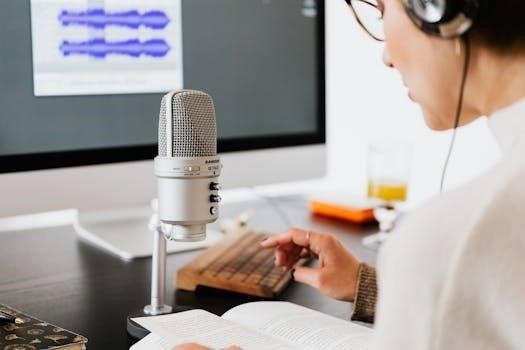
How to Talk to Anyone Book PDF⁚ A Comprehensive Guide
This guide explores Leil Lowndes’ “How to Talk to Anyone,” offering 92 practical techniques for improving communication and relationships. Discover actionable advice from making great first impressions to mastering small talk. The book emphasizes body language, engaging listeners, and building rapport for both personal and professional success.

Leil Lowndes’ “How to Talk to Anyone⁚ 92 Little Tricks for Big Success in Relationships” is a self-help guide focused on enhancing communication skills and building stronger relationships. This book, first published in 1998, remains a relevant resource, delving into the psychology of interactions. Structured into nine parts with 92 chapters, it provides actionable advice for improved social dynamics. It goes beyond basic communication, offering techniques to make powerful first impressions and mastering the art of small talk. The book offers practical tips on building rapport and handling difficult conversations. It emphasizes that success in life often hinges on how well you deal with others. The author presents easily implementable tools to improve both personal and professional relationships. Readers will discover that much communication is non-verbal and can use these techniques to make a lasting impact. This book is an essential read for anyone looking to improve their social skills and connect with people more effectively. It is a valuable guide for navigating the complexities of social interactions. This book aims to empower readers with the ability to leave a positive impression on people.
Key Concepts and 92 Little Tricks
“How to Talk to Anyone” is built upon the foundation of 92 actionable techniques designed to improve communication and interpersonal skills. These “little tricks” cover a wide spectrum of interactions, from initial encounters to ongoing conversations. The core concept emphasizes the importance of nonverbal cues, such as body language and eye contact, in shaping perceptions. The book stresses that effective communication is not just about what you say, but how you say it and how you present yourself. It introduces techniques to make you appear more confident, engaging, and likeable. Key concepts include the power of a genuine smile, the impact of sustained eye contact, and the art of active listening. It teaches you how to interpret body language and adjust your own accordingly. The book explores how to make a lasting first impression, navigate small talk with ease, and build rapport effectively. It also offers advice on avoiding common conversational pitfalls and handling difficult social situations. These 92 tricks provide a practical roadmap for enhancing social skills and fostering meaningful connections. This book helps anyone to improve their social relationships.
Making a Powerful First Impression
The book “How to Talk to Anyone” underscores the critical role of first impressions, noting that they are formed quickly and are often lasting. It details how to make a powerful first impression even before uttering a word. This involves mastering nonverbal cues such as posture, maintaining a confident stance with shoulders back and head held high, and displaying a genuine smile. The book emphasizes the importance of a slow, sincere smile to establish credibility. It also highlights the impact of eye contact, advising on how to use it effectively without being perceived as threatening. The “Big-Baby Pivot” technique is introduced to help you give your undivided attention to someone new. The first few moments of an interaction are crucial, making it vital to present an image of assurance and approachability. The book advises against fidgeting, which can signal nervousness or dishonesty. By being mindful of these aspects, one can create a positive and memorable initial encounter, setting the stage for successful interactions and relationships. It is important to note how people react to you at first sight.
Mastering Body Language and Nonverbal Cues
“How to Talk to Anyone” emphasizes that nonverbal communication often speaks louder than words. Mastering body language is crucial for effective interaction. The book explains how posture, gestures, and eye contact can significantly impact how others perceive you. It details how to use your body to convey confidence and approachability. For example, maintaining a direct gaze signifies respect and engagement, while avoiding fidgeting projects credibility. The text delves into the nuances of smiles, differentiating between genuine and insincere ones, and advises on using a slow smile for impact. The concept of “Sticky Eyes” and “Epoxy Eyes” are introduced to illustrate the power of intense eye contact, though caution is advised against overuse. The book also describes how a confident body naturally reflects inner assurance, with shoulders back, head up, and softened eyes. The book also emphasizes that people subconsciously judge you based on your body language, and that you have to be aware of it in the first seconds of the meeting. By understanding and controlling these nonverbal signals, individuals can build trust and make a lasting positive impression.
The Art of Small Talk and Conversation Starters
In “How to Talk to Anyone,” the art of small talk is presented as a crucial skill for social interaction. The book emphasizes that the purpose of small talk isn’t to impress, but to create comfort and connection. It encourages individuals to match the mood of their listeners, like music, and to focus on commonalities to break down initial barriers of fear. The book introduces the “whatzit” technique, using an unusual item to spark conversation. The text also advises on how to handle common questions like “Where are you from?” and “What do you do?” by providing more than one-sentence responses. It also suggests using anecdotes and stories to keep conversations engaging, and to focus on the other person, listening more than talking. You have to prepare stories, and have some topics in mind, before you are in a conversation, and to not say secrets at the start. The book also stresses the importance of active listening, using techniques such as repeating the last words of the speaker to keep conversations going, and observing nonverbal cues to gauge interest. These techniques transform mundane interactions into opportunities for meaningful connections.
Techniques for Engaging and Captivating Listeners
“How to Talk to Anyone” delves into techniques that transform ordinary conversations into captivating experiences. The book highlights that passion in your voice is more important than the actual words. Focusing on similarities puts people at ease and builds connections. The book also suggests letting the other person talk about themselves because they want to, and that you have to listen more than talk. The book advocates for using active listening skills, such as repeating the last words of the speaker, to keep conversations flowing. Another technique is to bring up exciting anecdotes that everyone knows, with more vivid descriptions. The book also teaches the importance of observing nonverbal cues, and to not bring up secrets at the start of the relationship. It also suggests to prepare topics in advance. The book emphasizes the importance of using the word “you” to show that you care about the listener’s perspective. It also talks about the importance of a varied smile, and the importance of avoiding cliches. To become a captivating speaker, it is very important to use your hands, body and gestures. These techniques, when applied, can transform your interactions and make you a more engaging conversationalist.
Building Rapport and Connecting with Others
“How to Talk to Anyone” provides numerous strategies for building rapport and creating genuine connections. The book emphasizes the importance of focusing on commonalities to break down barriers, highlighting that even mundane remarks can foster connection. One technique involves using a “whatzit,” an unusual item that sparks curiosity and conversation. The book suggests asking others to introduce you to specific people, allowing for more personalized interactions. When joining a group conversation, the book recommends listening first, and then interjecting relevant comments. It also offers advice to avoid one-sentence responses and to keep conversations flowing by describing what you do or what you are working on. The book also suggests giving extra details when introducing two people to facilitate conversation. It also emphasizes the importance of listening to clues and letting the other person lead the conversation. By focusing on the other person, you can find out their interests and what they want to talk about. The book also suggests using the word “you” to make your listener feel special. These techniques can greatly enhance your ability to build meaningful relationships.
Handling Difficult Conversations and Situations
While “How to Talk to Anyone” focuses on positive interactions, it also offers strategies for navigating challenging conversations. The book suggests that when wronged, it’s sometimes best to act as if nothing happened, even if angry, as bringing up mistakes can harm your reputation. It advises against hurting someone’s ego, even when deserved, and not dwelling on past errors. The book also provides guidance on avoiding confrontations at parties and maintaining pleasantries, suggesting that these interactions are not the place for conflict. The book also gives tips when someone does a good job, to let their boss know. It also suggests to give someone at least 24 hours to savor generosity before completing a favor. It also suggests to wait a while before asking for reciprocation after doing a favor. It is very important to be pleasant and to avoid confrontations at any parties. The book also emphasizes the importance of being able to read nonverbal cues, such as shifts in posture and eye contact, as indicators of deception. It offers insights on how to remain credible by limiting fidgeting and maintaining a composed demeanor. These techniques can help navigate difficult interactions with more confidence and grace.
Improving Communication Skills for Personal and Professional Success
“How to Talk to Anyone” emphasizes that effective communication is crucial for both personal and professional success. The book stresses that success isn’t solely about intelligence or looks, but about how well one interacts with others. It provides 92 actionable techniques to achieve this, including how to make a good first impression, build rapport, and master small talk. The book also emphasizes the importance of nonverbal cues, such as body language and eye contact, in conveying confidence and approachability. Learning to match the mood of the person you’re speaking to is also a key element in building relationships. The book teaches how to use your words and body language effectively, focusing on making the other person feel comfortable. It also highlights the importance of being a good listener, and how to engage and captivate others in conversation. The skills in this book help readers create meaningful connections and navigate conversations effectively, leading to improved outcomes in both personal and professional settings, by being able to understand and respond to others better.
Practical Application of the Book’s Techniques
The techniques in “How to Talk to Anyone” are designed for practical application in everyday situations, not just theoretical knowledge. The book encourages readers to start by focusing on nonverbal cues, like posture and eye contact, to make a powerful first impression. It advises on using smiles effectively to build credibility. Mastering small talk is crucial, starting with simple questions that match the mood of the listener. Engaging techniques include wearing a ‘whatzit’ to spark conversations, and using anecdotes to captivate listeners. The book also emphasizes the importance of listening and focusing on the other person, rather than oneself, to build rapport. It teaches how to handle common conversation pitfalls, such as running out of things to say, by using techniques like repeating the last words of the other person. The book also provides advice on how to improve your vocabulary, and how to use language to make a positive impact. By using the skills in the book, readers can learn to communicate more effectively in all aspects of their lives.
Where to Find the “How to Talk to Anyone” PDF
Finding a legitimate PDF version of “How to Talk to Anyone” by Leil Lowndes can be tricky, as unauthorized copies are often circulated online. The most reliable way to access the book is through authorized retailers, which usually offer digital versions in formats like PDF or ePub. Check major online bookstores, such as Amazon, Barnes & Noble, and Google Play Books, as they often have the official eBook version available for purchase. Look for the option to download the book as a PDF, which you may be able to do after buying the book. You can also explore the author’s official website, lowndes.com, which might provide links to authorized retailers. It’s essential to be cautious when downloading from less reputable sources, as these files might be infected with malware or violate copyright laws. Always verify the legitimacy of a source before downloading any digital content, especially books. Supporting the author by purchasing an official copy ensures you receive a genuine and safe version of the book, and in return, you help to support the future work of the author.


